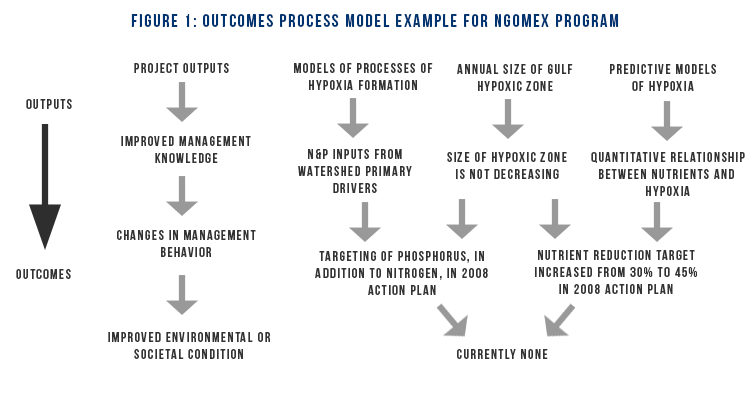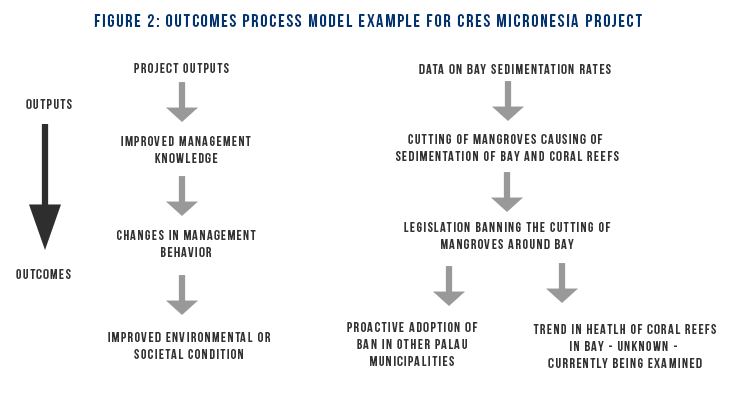Outputs and Outcomes

Clear articulation of outcome-based management goals is a required component of National Centers for Coastal Ocean Science (NCCOS) proposals (see FFO), and progress toward achieving management outcomes is required in NCCOS annual progress reports (see Reporting Requirements).
The proposal should articulate the plan for improving management effectiveness, specifying the management agencies that will be targeted, and the outputs and outcomes to be achieved. For the purposes of NCCOS proposals and reports, outputs and outcomes are defined as the following.
Outputs are defined as information or products that directly result from NCCOS-funded projects. Outputs are most frequently reported quantitatively (i.e., 7 publications and 12 presentations). In addition, an output may represent the result of NCCOS-funded monitoring activities. For example, NGOMEX-funded monitoring of the hypoxic zone in the Gulf of Mexico produces an output of the annual size of the hypoxic zone each summer (Fig. 1). Also called deliverables from a project management perspective, these direct products can include:
- New or advanced knowledge;
- Publications;
- Patents;
- Workshops;
- New methodologies or technologies;
- New or advanced tools (e.g., biomarkers, models);
- Presentations;
- Outreach Products.

Outcomes are changes in the knowledge or actions of the user (in this case, managers or policymakers) or a societal or environmental benefit that results from a project or program. These may be associated with either the funded research or activity or their resultant outputs. Outcomes are typically placed into three categories.
Improved Management Knowledge (or skill) tends to be short-term outcomes that can be manifest in a number of ways. However, because nearly all of NCCOS research will directly result in a new or improved knowledge or skill, these outcomes must represent demonstrable changes in knowledge within the management or policy community, in addition to the scientific community.
Changes in Management Behavior occur when there is a change in management approach, or managers act upon their improved knowledge. These outcomes are often intermediate in duration. These changes in behavior will most likely be manifest through changes in resource management protocols or actions.
Improved Environmental or Societal Condition, typically long-term, includes those activities that result in changes in values, conditions, or status of an environmental resource or ecosystem. This category comprises the ultimate goal of a NCCOS program.
In theory each one of these outcome types will lead to the other: Improved Management Knowledge → Changes in Management Behavior → Improved Environmental or Societal Condition (Benefit). Many outcomes, especially long-term changes in behaviors or values, can be difficult to quantify, and may manifest years after output generation. Some outcomes may be expressed as a trend of ecological or societal parameters over time (i.e., increasing acreage of healthy coral reefs or declining annual size of the Gulf hypoxic zone). In addition, the transition from one outcome to another is not likely to be linear, but likely the interplay of multiple outputs and outcomes.
Specific examples of NCCOS-related outcomes may include:
Management application or adoption of
- New fundamental or applied knowledge;
- Workshop results;
- New or improved skills;
- New or improved methods or technology;
- New or advanced tools (e.g., biomarkers, models);
Improved environmental or societal conditions
- Improved water quality;
- Lower frequency and severity of harmful algal blooms;
- Reduced hypoxic zone areas;
- Improved sustainability of fisheries;
- Healthy coral reefs.
Output and Outcome Examples
The Northern Gulf of Mexico Ecosystem and Hypoxia Assessment (NGOMEX) program supports the annual monitoring of hypoxic zone size in the Gulf of Mexico as well as the development of process and predictive models quantifying the relationship between the hypoxic zone, and its causes and impacts. The principle management driver for the hypoxic zone is the Hypoxia Task Force’s Action Plan, which has recently been revised based on a scientific reassessment. Several outputs and outcomes of NGOMEX projects were instrumental in development of the revised 2008 Gulf Hypoxia Action Plan (see process model in Figure 1). These included process models (outputs) that documented the role of nitrogen and phosphorus loading in hypoxia development, as well as predictive models (outputs) of hypoxic zone size based on nutrient loading. In addition, NGOMEX monitoring of the hypoxic zone produced an output of the annual size of the hypoxic zone. These outputs led to outcomes of Improved Management Knowledge; a) that the hypoxic zone size is not decreasing, b) that both nitrogen and phosphorus are important to hypoxia formation, and c) of the quantitative relationship between nutrient inputs from the watershed and hypoxic zone size. These outcomes of Improved Management Knowledge led to outcomes of Changes in Management Behavior (approach) in the 2008 Action Plan (e.g., changes from the 2001 Action Plan include targeting of phosphorus reduction, in addition to nitrogen reduction, and an increase in the nutrient reduction target from 30 to 45 percent). The ultimate goal of these Changes in Management Behavior outcomes is a reduction in hypoxic zone size, which should restore shrimp and fish habitat, among other ecosystem benefits (Improved Environmental or Societal Condition outcomes).
A second example stems from the Coral Reef Ecosystem Studies (CRES) Program’s Micronesia project, which took place in Palau (see process model in Figure 2). This project adapted a watershed model developed for other Pacific Islands in an effort to ascertain the cause of impaired coral reefs in Airai Bay in the Palauan State of Airai. An output of this project was detailed data on sedimentation rates in the bay. This data led to the outcome of improved knowledge that the cutting of mangrove forests was causing increased sedimentation rates into the bay and impacting the coral reefs. This outcome was presented to the Airai village chiefs, which resulted in the outcome of a moratorium on the cutting of mangroves throughout the entire State, a change in behavior. This change in behavior has potentially led to two additional outcomes of changes in societal values and environmental conditions. Following the State moratorium on mangrove cutting, other States in Palau are proactively modifying their watershed management practices and legislation is now pending at the National level to ban the cutting of mangroves in order to protect their coral reefs, a change in societal values. Additionally, the bay and coral reefs from the original study are currently being monitored to determine whether the ban on mangrove cutting has led to improved health of the reefs, a change in environmental condition.
